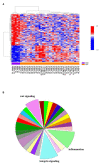Adipose Tissue Properties in Tumor-Bearing Breasts
- PMID: 32974182
- PMCID: PMC7472783
- DOI: 10.3389/fonc.2020.01506
Adipose Tissue Properties in Tumor-Bearing Breasts
Abstract
The tissue stroma plays a major role in tumors' natural history. Most programs for tumor progression are not activated as cell-autonomous processes but under the conditions of cross-talks between tumor and stroma. Adipose tissue is a major component of breast stroma. This study compares adipose tissues in tumor-bearing breasts to those in tumor-free breasts with the intention of defining a signature that could translate into markers of cancer risk. In tumor-bearing breasts, we sampled adipose tissues adjacent to, or distant from the tumor. Parameters studied included: adipocytes size and density, immune cell infiltration, vascularization, secretome and gene expression. Adipose tissues from tumor-bearing breasts, whether adjacent to or distant from the tumor, do not differ from each other by any of these parameters. By contrast, adipose tissues from tumor-bearing breasts have the capacity to secrete twice as much interleukin 8 (IL-8) than those from tumor-free breasts and differentially express a set of 137 genes of which a significant fraction belongs to inflammation, integrin and wnt signaling pathways. These observations show that adipose tissues from tumor-bearing breasts have a distinct physiological status from those from tumor-free breasts. We propose that this constitutive status contributes as a non-cell autonomous process to determine permissiveness for tumor growth.
Keywords: IL-8; adipose tissue; breast cancer; non-cell autonomous; permissive cancer niche.
Copyright © 2020 Miran, Scherer, Ostyn, Mazouni, Drusch, Bernard, Louvet, Adam, Mathieu, Haffa, Antignac, Le Bizec, Vielh, Dessen, Perdry, Delaloge and Feunteun.
Figures






References
LinkOut - more resources
Full Text Sources
Molecular Biology Databases

